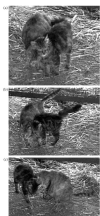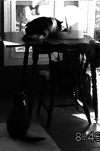Social organization in the cat: a modern understanding - PubMed (original) (raw)
Review
Social organization in the cat: a modern understanding
Sharon L Crowell-Davis et al. J Feline Med Surg. 2004 Feb.
Abstract
An increasing body of research work has made it clear that, while Felis catus can survive in the solitary state, social groups with an internal structure, are formed whenever there are sufficient food resources to support them. Most people who have cats have two or more cats. Failure to understand what will promote either friendly or aggressive behavior can lead to various behavior problems, including aggression and conflict over resources, such as food, resting sites and litterboxes. An understanding of the natural social organization, relationships and communication between cats is therefore essential, and is the subject of this paper.
Figures
Figure 1
Two domestic cats greet each other with a nose touch.
Figure 2
An allogrooming bout between three cats, a female and two of her adult offspring. Over the course of several minutes, each cat groomed the other two cats.
Figure 3
The cat in the middle solicits allogrooming from the cat on the right by lowering its head and flexing its neck. The solicited cat responded by allogrooming the head of the solicitor.
Figure 4
a, b, c. As part of an allogrooming sequence, two feral cats rub head to head, body to body and head to body.
Figure 5
Two feral cats engage in play behavior, one extending its paw to the other in solicitation of play.
Figure 6
Two feral farm cats that are preferred associates rest together, one laying its head on top of the other.
Figure 7
One male copulates with an estrous queen while another waits nearby. There was no aggression between these two males, or an additional two males that waited nearby.
Figure 8
A male grooms the ear of an estrous queen between copulations. Photo courtesy of Prince Royal Bengals.
Figure 9
Two cats stare at each other briefly before the cat on the right defers to the one the left by breaking eye contact and moving away.
Figure 10
A subordinate cat waits while a higher-ranking cat eats.
Similar articles
- Social interaction, food, scent or toys? A formal assessment of domestic pet and shelter cat (Felis silvestris catus) preferences.
Vitale Shreve KR, Mehrkam LR, Udell MAR. Vitale Shreve KR, et al. Behav Processes. 2017 Aug;141(Pt 3):322-328. doi: 10.1016/j.beproc.2017.03.016. Epub 2017 Mar 24. Behav Processes. 2017. PMID: 28343989 - Effects of Socialization on Problem Solving in Domestic Cats.
Foerder P, Howard MC. Foerder P, et al. Animals (Basel). 2024 Sep 7;14(17):2604. doi: 10.3390/ani14172604. Animals (Basel). 2024. PMID: 39272389 Free PMC article. - Owners' Attitudes, Knowledge, and Care Practices: Exploring the Implications for Domestic Cat Behavior and Welfare in the Home.
Grigg EK, Kogan LR. Grigg EK, et al. Animals (Basel). 2019 Nov 15;9(11):978. doi: 10.3390/ani9110978. Animals (Basel). 2019. PMID: 31731680 Free PMC article. - What's inside your cat's head? A review of cat (Felis silvestris catus) cognition research past, present and future.
Vitale Shreve KR, Udell MA. Vitale Shreve KR, et al. Anim Cogn. 2015 Nov;18(6):1195-206. doi: 10.1007/s10071-015-0897-6. Epub 2015 Jul 8. Anim Cogn. 2015. PMID: 26154131 Review. - A review of over three decades of research on cat-human and human-cat interactions and relationships.
Turner DC. Turner DC. Behav Processes. 2017 Aug;141(Pt 3):297-304. doi: 10.1016/j.beproc.2017.01.008. Epub 2017 Jan 22. Behav Processes. 2017. PMID: 28119016 Review.
Cited by
- Computational investigation of the social function of domestic cat facial signals.
Martvel G, Scott L, Florkiewicz B, Zamansky A, Shimshoni I, Lazebnik T. Martvel G, et al. Sci Rep. 2024 Nov 11;14(1):27533. doi: 10.1038/s41598-024-79216-2. Sci Rep. 2024. PMID: 39528681 Free PMC article. - 2024 AAFP intercat tension guidelines: recognition, prevention and management.
Rodan I, Ramos D, Carney H, DePorter T, Horwitz DF, Mills D, Vitale K. Rodan I, et al. J Feline Med Surg. 2024 Jul;26(7):1098612X241263465. doi: 10.1177/1098612X241263465. J Feline Med Surg. 2024. PMID: 39012263 Free PMC article. - Insights to Study, Understand and Manage Extruded Dry Pet Food Palatability.
Le Guillas G, Vanacker P, Salles C, Labouré H. Le Guillas G, et al. Animals (Basel). 2024 Apr 3;14(7):1095. doi: 10.3390/ani14071095. Animals (Basel). 2024. PMID: 38612333 Free PMC article. Review. - Semiochemicals from Domestic Cat Urine and Feces Reduce Use of Scratching Surfaces.
Zhang L, Aviles-Rosa EO, Bian Z, Surowiec K, McGlone JJ. Zhang L, et al. Animals (Basel). 2024 Feb 5;14(3):520. doi: 10.3390/ani14030520. Animals (Basel). 2024. PMID: 38338163 Free PMC article. - Feline Morbillivirus: Clinical Relevance of a Widespread Endemic Viral Infection of Cats.
Pennisi MG, Belák S, Tasker S, Addie DD, Boucraut-Baralon C, Egberink H, Frymus T, Hartmann K, Hofmann-Lehmann R, Lloret A, Marsilio F, Thiry E, Truyen U, Möstl K, Hosie MJ. Pennisi MG, et al. Viruses. 2023 Oct 13;15(10):2087. doi: 10.3390/v15102087. Viruses. 2023. PMID: 37896864 Free PMC article. Review.
References
- Baerends-Van Roon J.M., Baerends G.P., 1979. The morphogenesis of the behaviour of the domestic cat: With special emphasis on the development of prey-catching. Verhaelingen der Koninklijke Nederlandse Akademie van WetenschappenAfd. Natuurkunde, Tweede Reeks, Deel, 72.
- Barry K.J., Crowell-Davis S.L. Gender differences in the social behavior of the neutered indoor—only domestic cat, Applied Animal Behaviour Science, 64, 1999, 193–211.
- Bernstein I.S. Dominance: The baby and the bathwater, The Behavioral and Brain Sciences, 4, 1981, 419–457.
- Bradshaw J., Cameron-Beaumont C. The signalling repertoire of the domestic cat and its undomesticated relatives. Turner D.C., Bateson P. The Biology of the Domestic Cat, 2000, Cambridge University Press: Cambridge, 67–94.
- Cameron-Beaumont C.L., 1997. Visual and tactile communication in the domestic cat (Felis silvestris catus) andundomesticated small felids. PhD thesis, University of Southampton.
Publication types
MeSH terms
LinkOut - more resources
Full Text Sources
Miscellaneous









